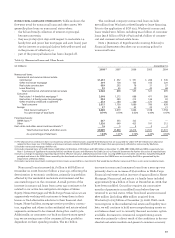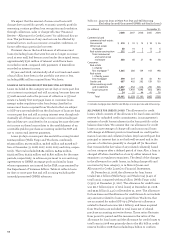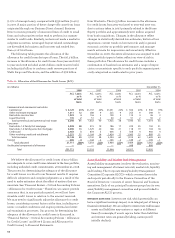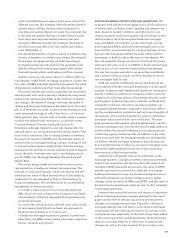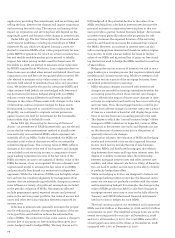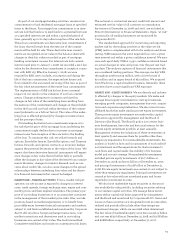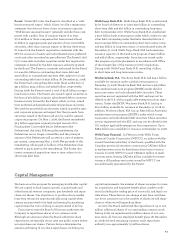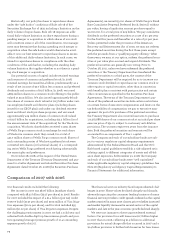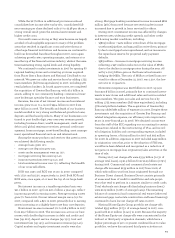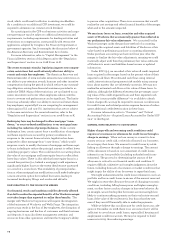Wells Fargo 2008 Annual Report Download - page 72
Download and view the complete annual report
Please find page 72 of the 2008 Wells Fargo annual report below. You can navigate through the pages in the report by either clicking on the pages listed below, or by using the keyword search tool below to find specific information within the annual report.application, providing the commitment, and securitizing and
selling the loan, interest rate changes will impact origination
and servicing fees with a lag. The amount and timing of the
impact on origination and servicing fees will depend on the
magnitude, speed and duration of the change in interest rates.
Under FAS 159, The Fair Value Option for Financial Assets
and Financial Liabilities, including an amendment of FASB
Statement No. 115, which we adopted January 1, 2007, we
elected to measure MHFS at fair value prospectively for new
prime MHFS originations for which an active secondary mar-
ket and readily available market prices existed to reliably
support fair value pricing models used for these loans. At
December 31, 2008, we elected to measure at fair value simi-
lar MHFS acquired from Wachovia. Loan origination fees on
these loans are recorded when earned, and related direct loan
origination costs and fees are recognized when incurred. We
also elected to measure at fair value certain of our other
interests held related to residential loan sales and securitiza-
tions. We believe that the election for new prime MHFS and
other interests held (which are now hedged with free-stand-
ing derivatives (economic hedges) along with our MSRs)
reduces certain timing differences and better matches
changes in the value of these assets with changes in the value
of derivatives used as economic hedges for these assets.
During 2008, in response to continued secondary market
illiquidity, we continued to originate certain prime non-
agency loans to be held for investment for the foreseeable
future rather than to be held for sale.
Under FAS 156, Accounting for Servicing of Financial
Assets – an amendment of FASB Statement No. 140, we elected
to use the fair value measurement method to initially mea-
sure and carry our residential MSRs, which represent sub-
stantially all of our MSRs. Under this method, the MSRs are
recorded at fair value at the time we sell or securitize the
related mortgage loans. The carrying value of MSRs reflects
changes in fair value at the end of each quarter and changes
are included in net servicing income, a component of mort-
gage banking noninterest income. If the fair value of the
MSRs increases, income is recognized; if the fair value of the
MSRs decreases, a loss is recognized. We use a dynamic and
sophisticated model to estimate the fair value of our MSRs
and periodically benchmark our estimates to independent
appraisals. While the valuation of MSRs can be highly subjec-
tive and involve complex judgments by management about
matters that are inherently unpredictable, changes in interest
rates influence a variety of significant assumptions included
in the periodic valuation of MSRs. Assumptions affected
include prepayment speed, expected returns and potential
risks on the servicing asset portfolio, the value of escrow bal-
ances and other servicing valuation elements impacted by
interest rates.
A decline in interest rates generally increases the propen-
sity for refinancing, reduces the expected duration of the ser-
vicing portfolio and therefore reduces the estimated fair
value of MSRs. This reduction in fair value causes a charge to
income (net of any gains on free-standing derivatives (eco-
nomic hedges) used to hedge MSRs). We may choose not to
fully hedge all of the potential decline in the value of our
MSRs resulting from a decline in interest rates because the
potential increase in origination/servicing fees in that sce-
nario provides a partial “natural business hedge.” An increase
in interest rates generally reduces the propensity for refi-
nancing, increases the expected duration of the servicing
portfolio and therefore increases the estimated fair value of
the MSRs. However, an increase in interest rates can also
reduce mortgage loan demand and therefore reduce origina-
tion income. In 2008, a $3,341 million decrease in the fair
value of our MSRs and $3,099 million of gains on free-stand-
ing derivatives used to hedge the MSRs resulted in a net loss
of $242 million.
Hedging the various sources of interest rate risk in mort-
gage banking is a complex process that requires sophisticated
modeling and constant monitoring. While we attempt to bal-
ance these various aspects of the mortgage business, there
are several potential risks to earnings:
• MSRs valuation changes associated with interest rate
changes are recorded in earnings immediately within the
accounting period in which those interest rate changes
occur, whereas the impact of those same changes in inter-
est rates on origination and servicing fees occur with a lag
and over time. Thus, the mortgage business could be pro-
tected from adverse changes in interest rates over a period
of time on a cumulative basis but still display large varia-
tions in income from one accounting period to the next.
• The degree to which the “natural business hedge” offsets
changes in MSRs valuations is imperfect, varies at differ-
ent points in the interest rate cycle, and depends not just
on the direction of interest rates but on the pattern of
quarterly interest rate changes.
• Origination volumes, the valuation of MSRs and hedging
results and associated costs are also impacted by many
factors. Such factors include the mix of new business
between ARMs and fixed-rated mortgages, the relation-
ship between short-term and long-term interest rates, the
degree of volatility in interest rates, the relationship
between mortgage interest rates and other interest rate
markets, and other interest rate factors. Many of these fac-
tors are hard to predict and we may not be able to directly
or perfectly hedge their effect.
• While our hedging activities are designed to balance our
mortgage banking interest rate risks, the financial instru-
ments we use may not perfectly correlate with the values
and income being hedged. For example, the change in the
value of ARMs production held for sale from changes in
mortgage interest rates may or may not be fully offset by
Treasury and LIBOR index-based financial instruments
used as economic hedges for such ARMs.
The total carrying value of our residential and commercial
MSRs was $16.2 billion at December 31, 2008, and $17.2 billion
at December 31, 2007. The weighted-average note rate on the
owned servicing portfolio was 5.92% at December 31, 2008,
and 6.01% at December 31, 2007. Our total MSRs were 0.87%
of mortgage loans serviced for others at December 31, 2008,
compared with 1.20% at December 31, 2007.







